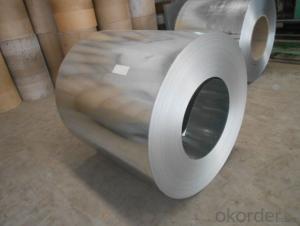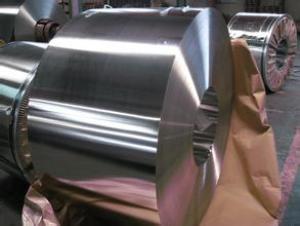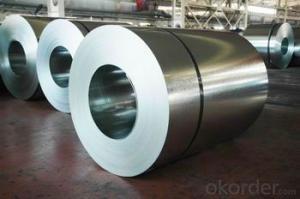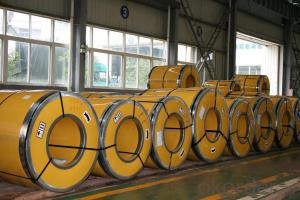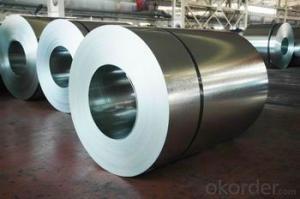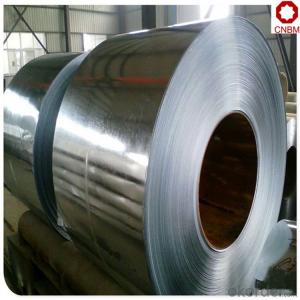Hot Dip Galvanized Steel Coil in coil
- Loading Port:
- Shanghai
- Payment Terms:
- TT OR LC
- Min Order Qty:
- 25 m.t.
- Supply Capability:
- 2500 m.t./month
OKorder Service Pledge
OKorder Financial Service
You Might Also Like
Hot Dip Galvanized Steel in Coil
Description:
Galvanized Steel Coil gets coated in layers of zinc because rust won't attack this protective metal. The most external layer is all zinc, but successive layers are a mixture of zinc and iron, with an interior of pure steel. These multiple layers are responsible for the amazing property of the metal to withstand corrosion-inducing circumstances. Zinc also protects the steel by acting as a "sacrificial layer." If rust does take hold on the surface of Superiority:
1. Good Resistance to Corrosion
2. Qualified Processing Machinability
3. High Thermal Resistance
4. Excellent Reflectivity
5. Inexpensive and effective enough
6. Can be recycled and reused multiple times
Application:
1. Architecture Roofs and outside walls of civilian and industrial buildings, garage doors, fencings and window blinds
2. Appliances Industry Outer clad sheets for washing machine, refrigerator, television, air conditioner and ventilation system, explosion-proof strip, solar water heater and appliance parts
3. Auto Industry Muffler, heat shields of exhaust pipe and catalytic converter, auto parts & accessories under the frame, signboard in highway
4. Industrial Instruments Electric control cabinet, industrial refrigeration equipment, automatic vending machine
Product Specification:
Material:SGCC,DX51D,Q195
Thickness: 0.3-3.0mm
Width: 600-1500mm
Inner Diameter: 508mm, 610mm
Weight of Steel Coil: 3-15MT
Coating Type: Al-Zn Alloy
Available Dipped Layer: 50-150g/m2
Surface Finish Structure: Normal Spangle & Small Spangle & Zero Spangle
Spangle: normal spangle, large spangle, small(min) spangle, zero spangle
FAQ:
1.How about the package for the Hot Dip Galvanized Steel in Coil?
Usually Standard export seaworthy package: waterproof paper+steel trip packed+wooden case seaworthy package
2. Can I know the production period of the goods?
Usually it need 20 days for 25tons in one container. We can produce 300 tons per day but we need to arrange the production in advance.
3. How about the label, could you make the label according to pour requirements?
Usually we use the MILL label, but if you need special form we can make.
- Q: How does the thickness of a steel coil affect its applications?
- The applications of a steel coil are significantly affected by its thickness. The thickness of the coil is what determines its strength, durability, and versatility, thus making it suitable for various uses in different industries. In industries where strength is of utmost importance, such as construction, thicker steel coils are preferred. Thicker coils provide higher structural integrity and load-bearing capacity, which are essential in projects involving buildings, bridges, and infrastructure. Moreover, thicker steel coils offer better resistance against bending, warping, and other forms of deformation, making them ideal for heavy-duty applications. The durability of a steel coil is also influenced by its thickness. Thicker coils exhibit greater resistance to wear, corrosion, and damage, making them suitable for harsh environments or applications that involve constant friction or exposure to elements. For instance, thicker steel coils are commonly utilized in the manufacturing of heavy machinery, automotive parts, and mining equipment, where durability is of paramount importance. Furthermore, the thickness of a steel coil determines its versatility and adaptability. Thinner coils can be easily shaped into different forms and sizes, making them suitable for applications that require intricate designs or tight tolerances. Industries such as automotive, aerospace, and consumer electronics often rely on thinner steel coils due to their lightweight and flexible nature. On the other hand, the weight and reduced flexibility of thicker steel coils may limit their range of applications. They are better suited for applications that prioritize strength and durability over versatility. These applications include structural components, large-scale machinery, and industrial equipment. To summarize, the thickness of a steel coil plays a pivotal role in determining its applications. Thicker coils offer increased strength, durability, and resistance, making them ideal for heavy-duty applications in the construction and manufacturing industries. Conversely, thinner coils provide versatility and adaptability, making them suitable for applications that require intricate designs or lightweight properties.
- Q: What temp does fire have to be to melt steel?
- There are different types of steel. Melting point of steel depends upon its contents. Generally the melting point of stell is above 1500 c.
- Q: How are steel coils used in the manufacturing of agricultural equipment?
- Steel coils are used in the manufacturing of agricultural equipment as they serve as a raw material for various components such as frames, chassis, and structural supports. These coils are shaped, cut, and welded to form the necessary parts, providing strength, durability, and stability to the equipment.
- Q: How are steel coils used in the production of agricultural irrigation systems?
- Steel coils are used in the production of agricultural irrigation systems to create the pipes and tubing that transport water to crops. These coils are formed into various designs to meet specific irrigation needs, ensuring efficient and reliable water distribution for optimal crop growth.
- Q: What are the common coil surface treatments?
- The common coil surface treatments include galvanization, electroplating, painting, and powder coating.
- Q: What is the weight of a typical steel coil?
- The weight of a typical steel coil can vary depending on its size and thickness. However, a common range for the weight of a steel coil is between 5 to 15 tons.
- Q: What are the different methods of cut-to-length shearing for steel coils?
- Steel coils can be cut-to-length using various methods, each with unique advantages and applications. Some commonly used methods include: 1. Rotary Shearing: This technique utilizes a rotating shear blade to cut through the coil. It offers excellent precision and can handle a wide range of material thicknesses. Rotary shearing is well-suited for high-volume production and allows for high cutting speeds. 2. Guillotine Shearing: In this method, a straight blade is employed to cut through the coil. It is a versatile technique that can handle different material thicknesses and widths. Guillotine shearing is relatively simple and efficient, making it a popular choice for many applications. 3. Slitting: Slitting involves creating multiple longitudinal cuts in the coil to produce narrower strips. It is commonly used when a coil needs to be divided into smaller coils or when narrower strips are necessary for specific applications. Slitting can be performed using either rotary or straight blades. 4. Laser Cutting: Laser cutting employs a high-powered laser beam to melt or vaporize the material, resulting in a precise and clean cut. It is ideal for cutting complex shapes or patterns and can handle both thin and thick steel coils. Laser cutting offers high accuracy and minimal material distortion. 5. Waterjet Cutting: In this method, a high-pressure stream of water mixed with abrasive particles is used to cut through the coil. It is suitable for a wide range of materials, including steel, and can achieve high accuracy. Waterjet cutting is often utilized for cutting thick coils or when minimizing heat-affected zones is crucial. Each method has its own strengths and limitations, and the selection depends on factors such as material thickness, required precision, production volume, and specific application requirements. Choosing the most suitable method is vital to ensure efficient and high-quality cut-to-length shearing for steel coils.
- Q: days. Use your knowledge of the corrosion of steel and aluminum to predict how they would look different after a week exposed to rainy weather. Explain your prediction.
- I'd expect appearance of reddish dots or stains of rust on steel, while aluminium should stay virtually unchanged. Explanation: Both materials oxidize in natural environment because of atmospheric moist, but in very different ways. As for steel, oxidation begins as reddish dots of rust which grow and become stains. Oxidation then progresses in depth causing decay of material, compromising its strength and structural integrity.
- Q: How are steel coils inspected for color consistency?
- Steel coils are inspected for color consistency using a variety of methods to ensure that the final product meets the desired specifications. One common method is visual inspection, where trained inspectors examine the steel coils under controlled lighting conditions to detect any variations in color. This is done by comparing the color of each coil to a standard color chart or a previously approved sample. Any discrepancies are noted and further analysis is conducted. Additionally, advanced technologies such as spectrophotometers may be employed to measure the color of the steel coils objectively. Spectrophotometers use light to measure the reflective properties of the steel surface, allowing precise color analysis. The obtained color data is then compared to the specified color range, and any deviations are flagged for further investigation. Furthermore, some manufacturers may use automated color measurement systems, such as colorimeters or color cameras, to inspect steel coils for color consistency. These systems can quickly and accurately assess the color of each coil, ensuring uniformity across the entire batch. Overall, the inspection of steel coils for color consistency involves a combination of visual inspection, spectrophotometry, and automated color measurement systems. This comprehensive approach helps to guarantee that the steel coils meet the required color standards, providing consistent and high-quality products to customers.
- Q: How do steel coils contribute to energy performance in buildings?
- Steel coils can contribute to energy performance in buildings by providing insulation and thermal efficiency. The coils are often used in HVAC systems to enhance the heating and cooling processes, thus reducing energy consumption and improving overall energy efficiency. Additionally, steel coils can be used in roofing and cladding systems, providing insulation and helping to maintain a comfortable indoor temperature. By effectively managing heat transfer and reducing energy loss, steel coils play a crucial role in enhancing energy performance in buildings.
Send your message to us
Hot Dip Galvanized Steel Coil in coil
- Loading Port:
- Shanghai
- Payment Terms:
- TT OR LC
- Min Order Qty:
- 25 m.t.
- Supply Capability:
- 2500 m.t./month
OKorder Service Pledge
OKorder Financial Service
Similar products
Hot products
Hot Searches
Related keywords
